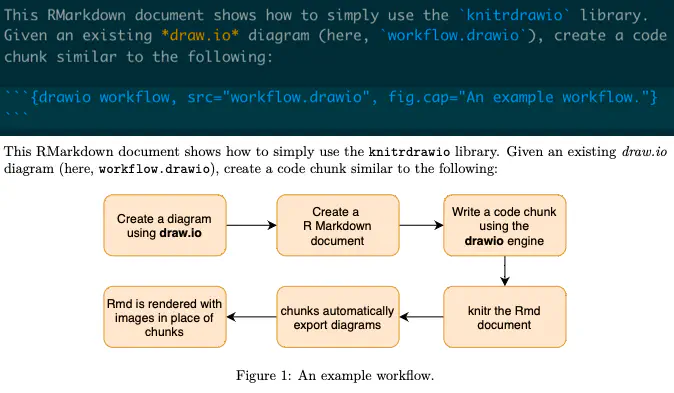knitrdrawio
 Using the knitrdrawio library and its result
Using the knitrdrawio library and its resultknitrdrawio is a publicly-available R package that brings a new engine to the knitr library, to automatically include draw.io diagrams in R Markdown documents (Rmd).
Rmd documents are powerful documents that increase reproducibility in research by integrating code chunks which are run when the document is processed by the knitr library and exported (e.g., to PDF or HTML webpages). Typical usages of such code chunks include, for example, the plotting of figures based on experiments data.
However, no tool was easily accessible to include diagram images, especially those created by a third-party software, such as draw.io.
Before knitrdrawio, the alternative would have been to manually export
the diagram from draw.io as an image (e.g., PNG, JPG, or PDF), and then
to manually include it in the R Markdown document, as one would do with
any Markdown document ([Image name](/path/to/image.png)).
This workflow is rather cumbersome and does not support the stakes of reproducibility, open science and reusability. Indeed, the export process, and its parameters, are separated from the rest of the document. One has to remember how to export the diagrams, from which source files, which are the correct versions, etc. Moreover, many scientists only include the exported images in their Version Control System (VCS), which makes it more difficult to modify the diagram later on (“where is that source file?!”).
knitrdrawio was built to solve this, by extending the knitr library with a new chunk engine, which allows to seamlessly export and include draw.io diagrams.
Automatically exporting and including a diagram is as simple as writing:
```{drawio my-super-diag1, src="diag1.drawio"}
```
This code chunk is replaced by the actual image, automatically exported
from the diag1.drawio diagram file, during the knitting process.
Of course, parameters can be added to control the export process:
```{drawio my-super-diag2, src="diag2.drawio", border=5, crop=FALSE, page.index=4}
```
Notice how the parameters are directly written in the document itself: any people trying to re-create your document (including future you!) will export the diagram exactly as you intended.
As a bonus, knitrdrawio builds upon knitr’s caching mechanism to avoid re-executing chunks if unnecessary. This means that, if you chose to enable cache, the chunk will be executed only once, as long as neither the parameters nor the diagram source file are changed.
See the GitHub page for more details, or start using knitrdrawio in your Rmd documents right away:
```{r setup}
install.packages("remotes")
remotes::install_github("rchaput/knitrdrawio")
library(knitrdrawio)
```